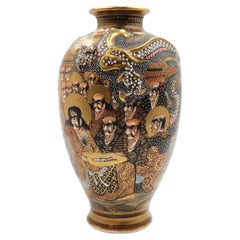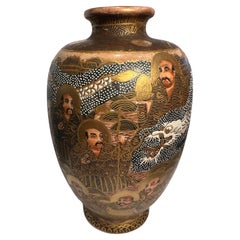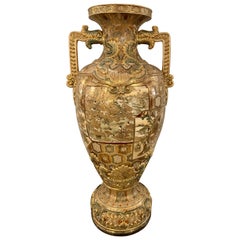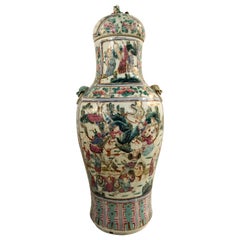Thousand Faces Vase
Antique 19th Century Japanese Meiji Ceramics
Ceramic
Antique 19th Century Japanese Meiji Ceramics
Earthenware, Pottery
Recent Sales
Vintage 1950s Chinese Export Vases
Ceramic
Vintage 1950s Chinese Export Ceramics
Ceramic
Antique 19th Century Chinoiserie Vases
Ceramic
People Also Browsed
2010s Brazilian Swivel Chairs
Straw
Antique Early 1800s English Georgian Beds and Bed Frames
Upholstery, Mahogany
Mid-20th Century Brazilian Mid-Century Modern Lounge Chairs
Leather, Wood
Mid-20th Century American Louis XVI Vanities
Mirror, Fruitwood
Antique Late 19th Century French Belle Époque Chairs
Fabric, Giltwood
21st Century and Contemporary Portuguese Modern Wall Mirrors
Brass
Late 20th Century Chinese Screens and Room Dividers
Wood, Paper
Late 20th Century Japanese Screens and Room Dividers
Wood, Paper
Vintage 1930s American Art Deco Decorative Boxes
Metal, Enamel
Vintage 1940s French Art Deco Dining Room Tables
Ormolu
20th Century Indian Tribal Sculptures and Carvings
Wood
Vintage 1970s American Mid-Century Modern Beds and Bed Frames
Brass
21st Century and Contemporary Victorian Landscape Paintings
Oil, Canvas
Antique 19th Century Thai Antiquities
Bronze
20th Century French Napoleon III Architectural Elements
Stone
Mid-20th Century French Mid-Century Modern Tapestries
Brass
Thousand Faces Vase For Sale on 1stDibs
How Much is a Thousand Faces Vase?
Finding the Right Ceramics for You
With their rich and diverse history, antique, new and vintage Asian ceramics offer colorful and sophisticated ways to add flair to any space.
Japanese pottery dates back at least 13,000 years to the Jōmon period. Pieces from the Late Jōmon era display a rope-cord pattern encircling a pot or jug. During the Muromachi period, potters created simple bowls and utensils frequently used in tea ceremonies and were made as both functional and aesthetic objects.
Ceramics made during Japan’s Meiji period, from 1868 to 1912, reflected an explosion of artistic expression propelled by new access to international trade. Details became more intricate and refined, and colors were enhanced with new glazing practices.
Chinese porcelain, meanwhile, is often identified by its shape. Each reign and dynasty had specific shapes and styles that were encouraged by the imperial ruler. During the Song dynasty, for instance, there were four dominant types of ceramic vase shapes: plum-shaped, pear-shaped, cong-shaped (tall and square) and double-gourd.
Chinese ceramics that were made during the Qing dynasty were demonstrative of an expanded artistic expression, with more delicate shapes and a focus on intricate detailing. The shapes of ceramics from this era are thinner, taller and have subtle features like a gentle flare, such as on the mallet-shaped vase.
Later, the 17th- and 18th-century interior design trend of chinoiserie brought Asian paintings and screens, textiles and other art and furniture from the continent into many European homes.
Explore an extensive range of antique, new and vintage Asian ceramics on 1stDibs to find the perfect piece for your home.
- What is a face vase?1 Answer1stDibs ExpertApril 5, 2022A face vase is a type of decorative object with an open top and a design that resembles a human face. In some cases, the facial features extend outwards from the vase. Other pieces feature carved, engraved or painted faces. On 1stDibs, find a selection of face vases.
Read More
Symbols of Happiness and Rebirth Adorn This Japanese Satsuma Bowl
Decorated with white cranes and the sought-after thousand-butterflies motif, the Meiji-period vessel offers both a celebration of traditional aesthetics and a clear reflection of the era’s appetite for exquisite export pieces.
Chicago’s Pagoda Red Has a Spirited Mix of Asian Antiques and Bold New Art
For 25 years, gallerist Betsy Nathan has leveraged her keen eye and key connections to bring a unique selection of rare finds to the market.
In L.A., Gallerist JF Chen Has Long Championed Eclectic Blue-Chip Design
Now working alongside his daughter Bianca, dealer Joel Chen has presented a most covetable array of antiques, art and contemporary creations for more than 40 years.
12 Calming Spaces Inspired by Japanese Design
From cherry-blossom-adorned walls paired with glamorous lighting to wood-paneled ceilings above checkerboard-patterned chairs, these 12 spaces seamlessly blend Eastern and Western aesthetics.
Rodrigo Rivero Lake’s Mexico City Showroom Is a Museum-Worthy Trove of Spanish Colonial and Asian Antiques
The dealer and curator has spent the past 50 years amassing a collection of exceptional art, furniture and architectural elements that trace the cultural influence of the Spanish empire from Europe to the Americas and beyond.
16 Refined Asian-Inspired Interiors
These spaces exemplify how Eastern elements elevate a home's decor.



